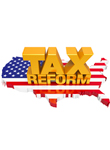For months, President Trump encouraged Congress to have tax reform legislation on his desk by Christmas 2017. The House passed their version of the bill on November 16th; the Senate passed their version on December 2nd. Republican Congress members worked together and approved a final bill on December 20th, which Trump signed into law on the 22nd. The legislation, titled The Tax Cuts and Jobs Act is based on “Unified Framework for Fixing Our Nation’s Broken Tax Code,” written by Trump officials and GOP leadership.
This new legislation is the first major tax reform in the United States since the Tax Reform Act of 1986 under President Reagan. For many, the change is long overdue. The National Retail Federation was a vocal advocate for the 2017 tax reform, saying the legislation will “dramatically benefit businesses, workers, and consumers.”
NRF also reports, “While much of the debate over business tax reform focused on the corporate tax rate, NRF pushed for tax relief for small businesses as well because 98 percent of retailers are small businesses and provide 40 percent of retail employment.”
The new legislation reduced the maximum corporate tax rate from 35% to 21%. This is great news for corporations, but around 75% of small businesses do not fall under this category. Most small businesses are classified as “pass-through” entities such as an LLC or sole proprietorship, not as corporations. This classification means the small business owner pays taxes for their business through their personal tax returns.
Impact on Small Businesses
Previously, small business owners were subject to personal income tax brackets up to 39%. Meaning, some small business owners would pay higher tax rates on their business income than corporations. Under the new law, individuals filing with pass-through companies can deduct up to 20% of their business income. There are several caveats to this deduction. Generally, to qualify for the full 20% deduction, your taxable income needs to be below $157,500 for single filers and $315,000 for joint filers. If your taxable income is above that threshold, it is still possible to qualify for deductions through employee wages or by holding depreciable property. So, if you are the owner of a pass-through business and your taxable income is above $157,500, hiring additional employees or increasing wages could provide you with a larger tax break.
Impact on Individuals
Your personal tax bracket is still very important, and this bill also makes a few changes there. Most small and medium-sized retailers are pass-through entities, meaning you pay taxes for both your business and personal income together in one filing. Republicans had hoped to reduce the number of tax brackets to simplify the process. However, under the new plan, there are still seven federal tax brackets, the rates are just slightly different. As you can see in the chart below, most income earners will have a lower tax rate, but there are some higher income groups in the middle who may pay a little more.
| Old Rate | Old Bracket | New Rate | New Bracket |
| 10% | < $9,525 | 10% | < $9,525 |
| 15% | $9,525 – $38,700 | 12% | $9,525-$38,700 |
| 25% | $38,700-$93,700 | 22% | $38,700-$82,500 |
| 28% | $93,700-$195,450 | 24% | $82,500 – $157,500 |
| 33% | $195,450-$424,950 | 32% | $157,500-$200,000 |
| 35% | $424,950-$426,700 | 35% | $200,000-$500,000 |
| 39.6% | $426,700+ | 37% | $500,000+ |
What’s the Bad News?
This new legislation limits state and local tax deductions to $10,000. Meaning, anyone who lives in areas with high state tax, such as New York or California, may not get as large of a break on Federal taxes.
Contrary to rumors, the 2017 tax reform bill does not eliminate deductions for small business expenses. However, there are some new restrictions on certain types of itemized deductions such as entertainment deductions.
Under the new tax law, the standard deduction has drastically increased from $6,350 for single filers and $12,700 for joint filers to $12,000 for single filers and $24,000 to joint filers. Overall, this is great news. However, since the standard deduction has increased, the itemized deduction threshold also increased. Essentially, the new law encourages taxpayers to opt for the standard deduction by reducing the value of some itemized deductions and increasing the value of itemized deductions needed to receive a tax break. In other words, many people who took itemized deductions in the past may be better off using the standard deduction.
What Should I Do Right Now?
The IRS and Treasury Department say they will release a new tax calculator this month. This will help individuals make sure they are putting aside the correct amount of taxes under the new system. The IRS strongly recommends all business owners and individuals use that tool once it is available.
For many small businesses, your employees will likely pay less income tax due to the new bracket rates and a larger standard deduction. So, make sure you also encourage them to use the new IRS calculation tool. Provide employees the opportunity to adjust their W2 forms as necessary.
Bottom Line
The Tax Cuts and Jobs Act doesn’t go into effect until the 2018 tax year. Your 2017 taxes that are due this April are not impacted, so there is no need to panic. But, you want to make sure you are setting yourself up for a smooth tax season next year. Consider hiring an accountant or another tax professional if you have not already done so. There are many changes that could benefit business owners, but only if you take advantage of them.

